- Get link
- X
- Other Apps
25 Stunning Eco-Friendly Concrete Floor Designs for Sustainable Homes
© 2025 Quality Coatings LLC - All Rights Reserved.
Quality Coatings LLC at 419-551-1064
Serving the Greater Fort Wayne and Tri-State area.
If you're looking to make your home more sustainable, eco-friendly concrete floors could be just the ticket. Not only do they offer durability and style, but they also help reduce your environmental footprint. Let's explore how these sustainable flooring options can enhance your living space while supporting a greener future.
Low VOC Sealers for Healthy Indoor Air Quality
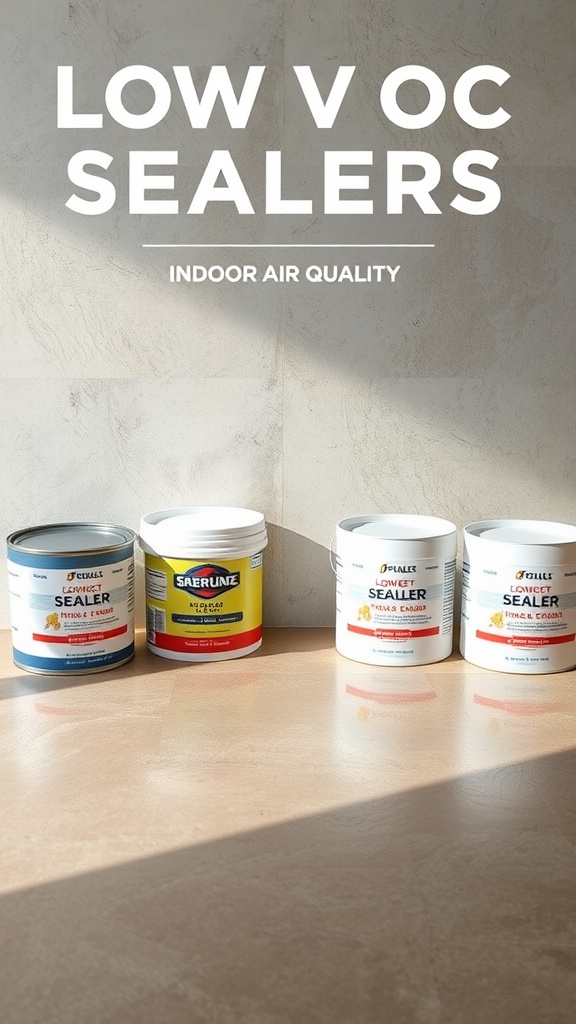
When it comes to maintaining a healthy home environment, choosing low VOC sealers is a smart move. The image above showcases several cans of low VOC sealers, lined up and ready to help you create a safe indoor atmosphere.
These sealers are designed to minimize volatile organic compounds, or VOCs, which can contribute to poor air quality. With the right products, you can enjoy the beauty of concrete floors without compromising on health.
Using low VOC sealers means less off-gassing, which is beneficial for everyone in your home, especially for those with sensitivities. It’s a simple way to ensure that the air you breathe is cleaner and fresher.
In choosing a sealer, look for labels that specifically mention low VOCs. This way, you can be sure that you’re making an eco-friendly choice that supports a sustainable lifestyle. Consider the types of sealers available—many are not only effective in protecting your floors but also in enhancing their natural beauty.
The Aesthetic Appeal of Polished Concrete

Polished concrete floors have a unique charm that can transform any space. The image showcases a spacious room with large windows letting in natural light, highlighting the smooth surface of the concrete floor. This soft, muted color palette creates a calming atmosphere, making the space feel inviting.
The contrast between the sleek flooring and the natural decor adds character. A simple plant and a stylish coffee table set the tone for a modern yet warm environment. The carefully chosen furnishings and the clean lines of the room emphasize how polished concrete can blend seamlessly with various design styles.
Not only do these floors look good, but they are also practical. They require minimal maintenance and can withstand heavy foot traffic, making them ideal for busy households. Plus, they pair well with eco-friendly living, aligning with sustainable home choices.
Durability and Longevity of Concrete Floors
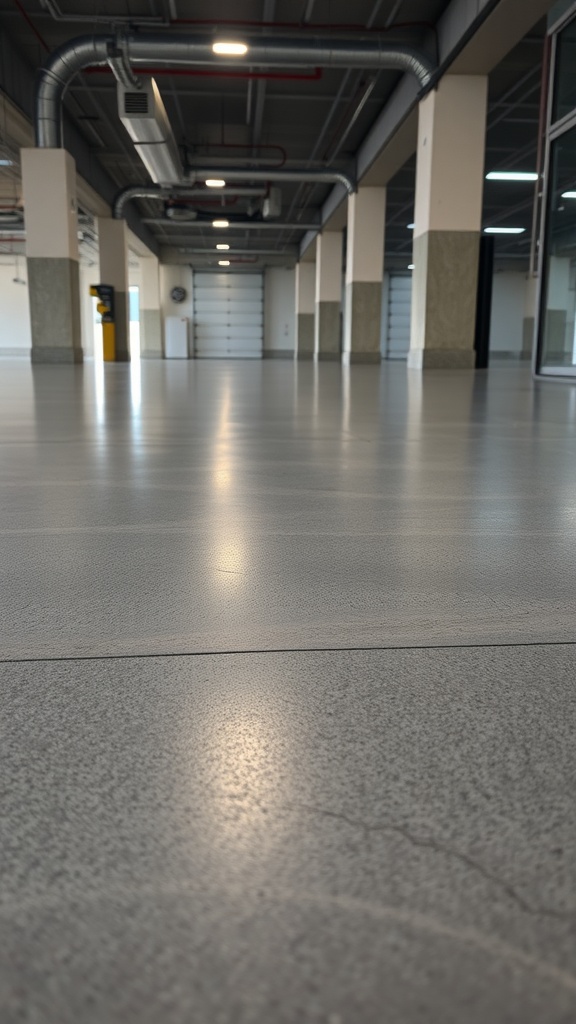
Concrete floors are more than just a solid base; they are a smart choice for anyone looking to create a sustainable home. The image above beautifully showcases a smooth, polished concrete floor that reflects light, indicating its well-maintained surface. This kind of durability is one of the many reasons homeowners are turning to concrete.
When we talk about durability, concrete floors shine. They can withstand heavy foot traffic, making them ideal for busy households or commercial spaces. Unlike wood or tile, they resist scratches and dents, allowing them to maintain their appearance over time. Plus, they don't warp or become easily damaged by moisture, which can be a significant concern with other materials.
Longevity is another big plus. Concrete floors can last for decades, reducing the need for replacements. This longevity not only saves money in the long run but also contributes to a more sustainable home. With fewer materials ending up in landfills, you're making a positive impact on the environment.
In addition to their strength and lifespan, concrete floors can be customized to suit your home's aesthetic. Whether you prefer a glossy finish or a more natural look, there are plenty of options available. This flexibility means that eco-friendly concrete floors can fit seamlessly into any design.
Sustainable Design Principles for Concrete Installations

Concrete floors can play a big role in sustainable home design. The image shows a bright, airy space with concrete steps leading up to a cozy seating area. This kind of setup not only looks modern but also highlights the versatility of concrete.
Using eco-friendly concrete means opting for materials that reduce environmental impact. Look for mixes that contain recycled materials or natural additives. This choice helps in minimizing carbon footprints and supports a greener building process.
The clear, open design in the image also emphasizes natural light. Incorporating windows or skylights can reduce energy consumption, making your concrete installation more efficient. It’s all about balancing aesthetics with functionality.
Additionally, plants in the image add a touch of nature, improving indoor air quality. Incorporating greenery is a smart way to enhance the space while promoting sustainability. When planning your concrete installation, think about how each element can contribute to a healthier living environment.
Types of Eco-Friendly Concrete Options
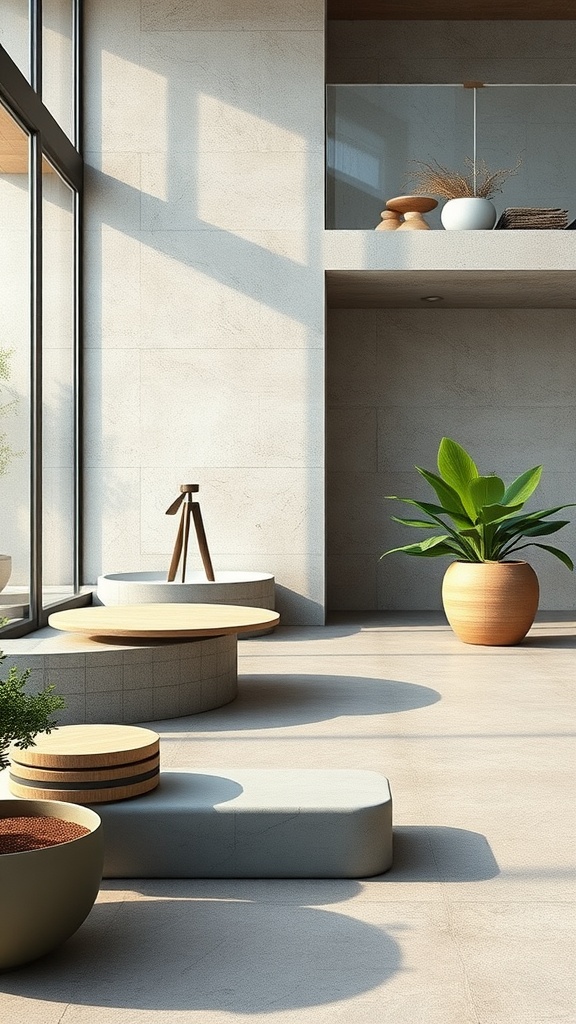
When it comes to eco-friendly concrete floors, there are several options to consider. The image above showcases a modern space that beautifully highlights the aesthetic appeal of concrete. Smooth, light-colored surfaces create a serene atmosphere, making concrete not only functional but also stylish.
One popular option is recycled concrete. This type uses crushed concrete from old structures, reducing waste and providing a unique look. You can often see interesting textures and colors that tell a story of the materials' history.
Another choice is permeable concrete, which allows water to flow through it, minimizing runoff. This feature helps in maintaining the natural water cycle and reduces flooding risks in urban areas. Imagine how this could fit well in a home surrounded by nature.
Lastly, there’s stained concrete, which can be customized in many colors. This method allows homeowners to express their individual style while benefiting from a durable surface. As seen in the image, adding some greenery and natural elements can enhance the ambiance and connection to the outdoors.
Energy Efficiency and Thermal Mass of Concrete
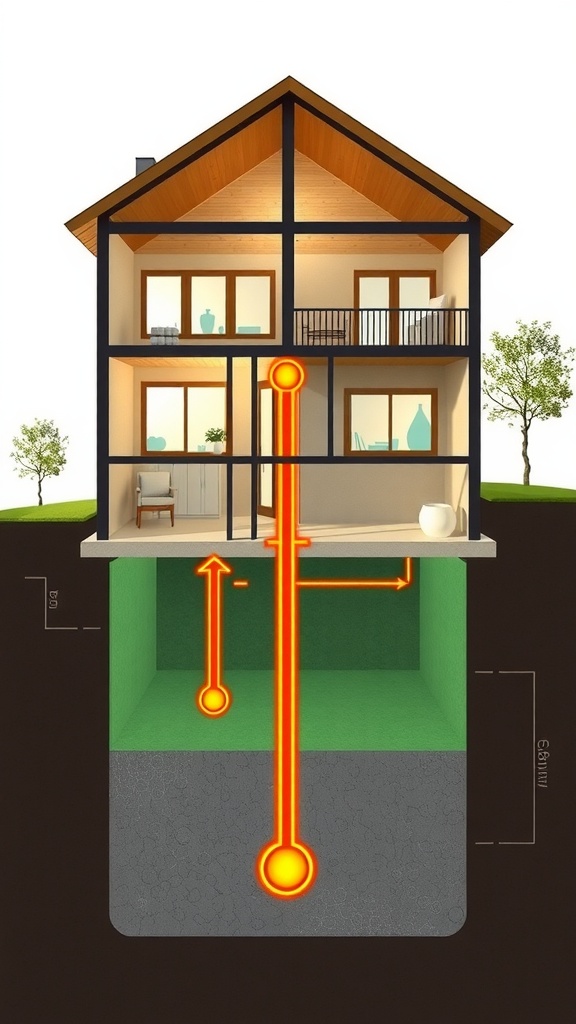
Concrete floors have a unique ability to enhance energy efficiency in homes. They work as thermal mass, meaning they can absorb, store, and release heat. When the sun shines on a concrete surface, the material heats up during the day and cools down at night, helping to regulate indoor temperatures.
The image shows a cutaway view of a home with concrete flooring. You can see how the thermal mass is integrated within the structure. The red circles highlight key areas where the heat management takes place. This helps maintain a comfortable environment without over-relying on heating and cooling systems.
By choosing eco-friendly concrete floors, homeowners can reduce their energy bills. The natural properties of concrete mean less energy is needed for heating in winter and cooling in summer. This aspect is especially useful in climates with extreme temperature changes.
Additionally, using concrete in construction can minimize the carbon footprint of a home. It lasts a long time and requires less maintenance, which aligns well with sustainable building practices. Overall, concrete floors offer a practical solution for those looking to create energy-efficient, eco-friendly homes.
The Role of Recycled Materials in Concrete
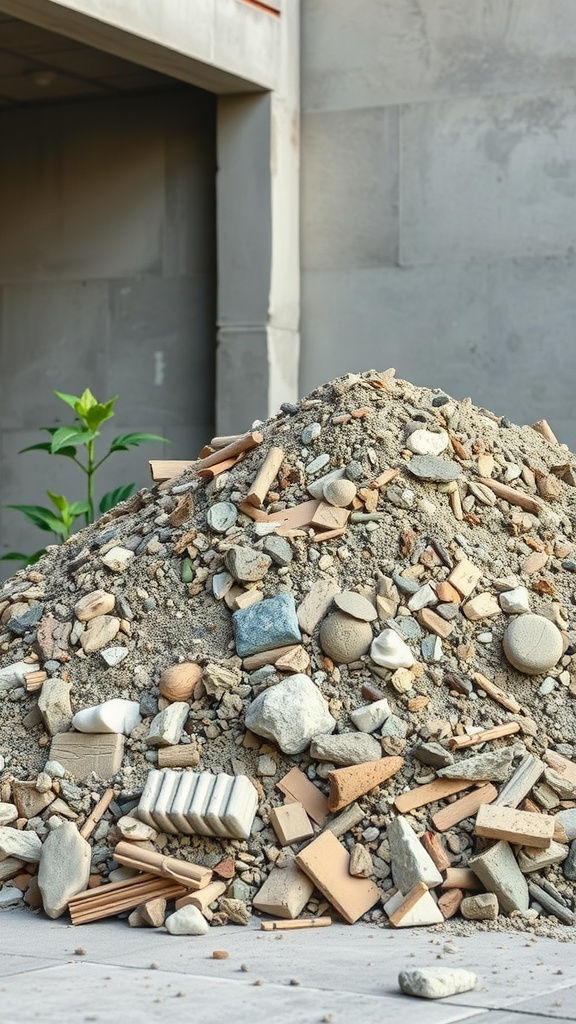
Concrete is a staple in the construction world, but it doesn’t have to come from new materials all the time. The image shows a pile of mixed debris, which includes a variety of recycled components. This debris can be transformed into eco-friendly concrete, reducing waste and conserving resources.
Using recycled materials in concrete not only lessens the environmental impact but also adds unique textures and colors. The mix can include crushed bricks, tiles, and stones, which can enhance the overall look of the flooring in sustainable homes. This blend helps create a strong and durable floor that has character and charm.
Besides aesthetics, opting for recycled materials helps in minimizing the carbon footprint associated with concrete production. Traditional concrete requires a significant amount of energy to produce, contributing to greenhouse gas emissions. By recycling, we can cut down on these emissions and promote a more sustainable building practice.
Incorporating recycled materials also supports local economies as it often involves sourcing materials from nearby demolition sites. This not only reduces transportation emissions but also promotes a circular economy, where materials are reused and repurposed.
Benefits of Choosing Eco-Friendly Concrete Floors

Eco-friendly concrete floors are not only stylish but also bring a lot of benefits to your home. The image shows a modern space with concrete flooring, complemented by greenery that adds a touch of life. This combination showcases how eco-friendly choices can blend seamlessly with contemporary design.
One major benefit is durability. Concrete floors can last for decades, reducing the need for replacements. This longevity means less waste, which is a win for the environment. When you opt for eco-friendly concrete, you also choose materials that are often made from recycled components. This helps lower your carbon footprint.
Additionally, these floors are low maintenance. A simple sweep and occasional mop will keep them looking fresh. This not only saves time but also reduces the need for chemical cleaners, making your home healthier. Plus, concrete retains coolness in warmer months, which may help you save on energy bills.
Lastly, concrete floors offer versatility. You can customize the color and finish to match any decor style. This flexibility allows you to create a unique space without compromising on sustainability. So, if you're considering a flooring option that is both eco-friendly and stylish, concrete is definitely worth exploring.
Cost-Effectiveness of Eco-Friendly Concrete Solutions
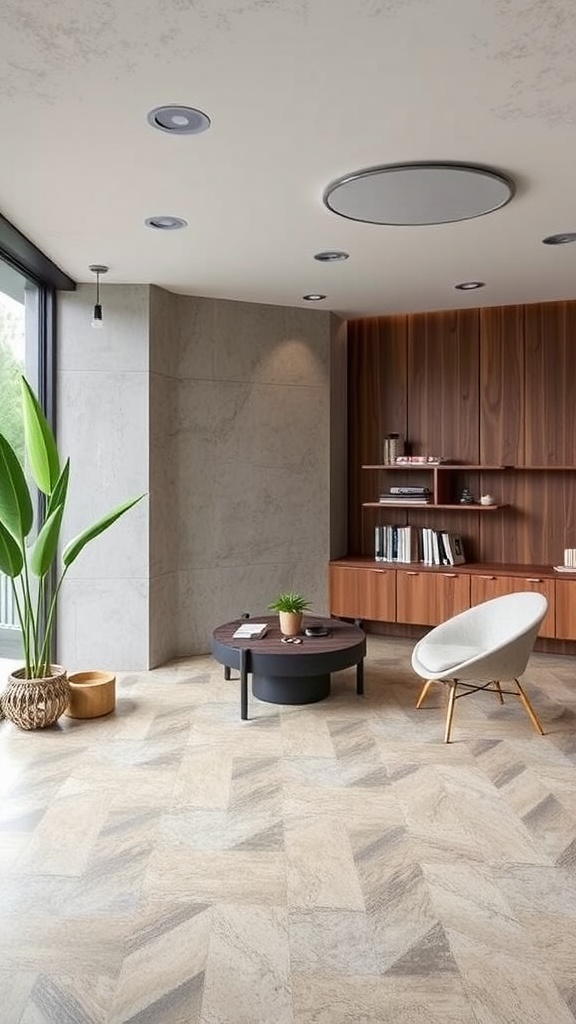
When considering home renovations, cost is always a big factor. The image highlights the financial benefits of eco-friendly concrete solutions compared to traditional flooring options. With eco-friendly concrete priced at approximately $135, it presents a budget-friendly choice for homeowners looking to maintain sustainability without breaking the bank.
In comparison, traditional flooring can range from $150 to over $2,000, depending on the type and quality. This substantial difference shows that eco-friendly concrete not only supports the environment but also helps save money. Additionally, the ongoing maintenance costs are generally lower with concrete, making it a smart investment in the long run.
The image also presents a breakdown of costs for different flooring types. With eco-friendly options only slightly higher than some alternatives, it’s clear that going green doesn't have to be a costly decision. By choosing eco-friendly concrete floors, homeowners can enjoy a stylish and sustainable space while being mindful of their budget.
Trendy Textural Finishes for Concrete
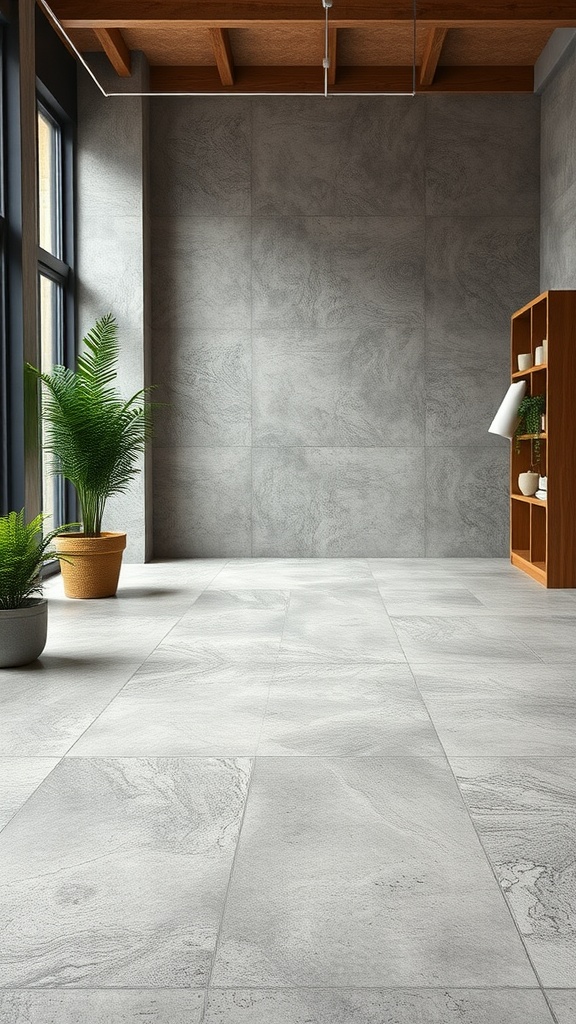
Concrete floors are stepping into the spotlight with a fresh twist. In homes aiming for sustainability, eco-friendly concrete finishes bring a unique touch that's both stylish and practical. The image showcases a modern space where smooth, gray concrete tiles blend beautifully with natural elements.
The soft textures and subtle patterns in the flooring create an inviting atmosphere. This type of finish can mimic other materials while offering the durability concrete is known for. With a variety of textural options, homeowners can easily customize their spaces to reflect personal style.
Incorporating plants and wooden accents, like the shelving seen in the image, enhances the look even further. This combination supports a harmonious balance between nature and modern design. Eco-friendly concrete not only supports a green lifestyle but also adds warmth and character to any room.
Water-Resistant Properties of Concrete Floors

The image features a spacious area with large letters spelling out 'Water' against a backdrop of polished concrete flooring. This setting perfectly illustrates the conversation around water-resistant properties, highlighting how concrete floors can withstand moisture while maintaining their durability.
Concrete floors are naturally resistant to water, making them an excellent choice for various spaces in your home. This is particularly beneficial in areas like basements, kitchens, or bathrooms where water exposure is common. The shiny surface in the image also indicates that these floors can be treated to enhance their water resistance further, which helps prevent mold and mildew growth.
Moreover, the combination of colors in the floor tiles shows that concrete can be both functional and stylish. With the right sealant applied, concrete floors can repel water, ensuring that spills and leaks do not penetrate the surface. This not only protects the flooring but also contributes to a healthier living environment.
Ultimately, if you're aiming for a sustainable home, investing in water-resistant concrete floors is a wise choice. They offer peace of mind regarding moisture issues while also being easy to clean and maintain. So, why not consider them for your next home improvement project?
Integrating Concrete Floors with Nature
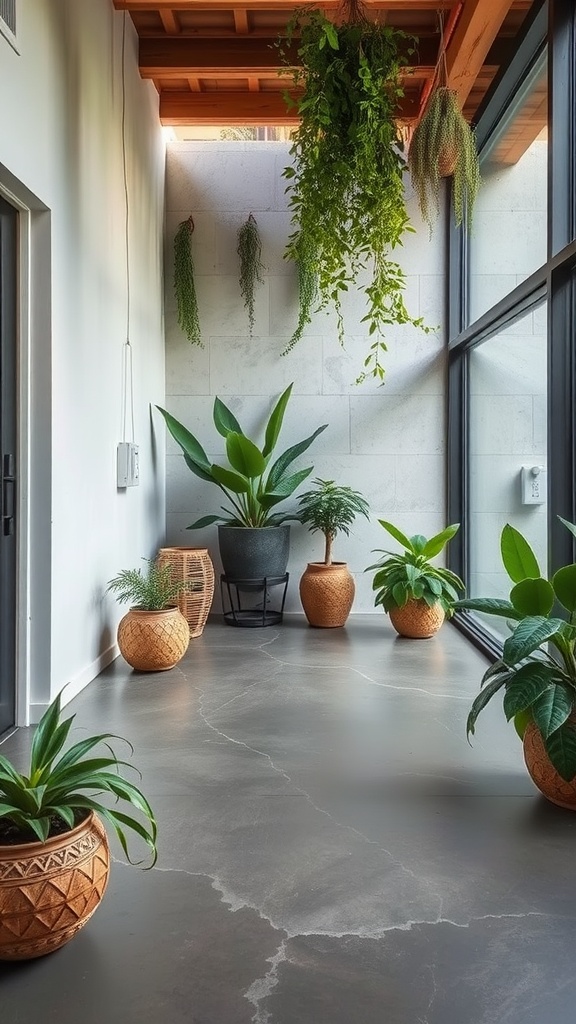
Concrete floors are not just practical; they can also enhance your connection to nature. The image showcases a beautifully designed space where concrete meets greenery. The sleek, polished surface of the floor complements the vibrant plants surrounding it.
Incorporating plants into your home brings life and a sense of tranquility. The terracotta and white pots add a warm touch, creating a contrast against the coolness of the concrete. This blend of materials encourages a harmonious atmosphere, making it perfect for relaxation or gatherings.
Using eco-friendly concrete helps reduce your carbon footprint while maintaining a stylish look. It's durable, easy to maintain, and can be customized to fit any decor. The large windows in the image let in natural light, highlighting the beauty of both the concrete and the greenery.
Think about adding other natural elements like wood or stone to further integrate your space with the outdoors. This can create a seamless transition from inside to outside, enhancing the overall aesthetic of your sustainable home.
Incorporating Natural Pigments in Concrete
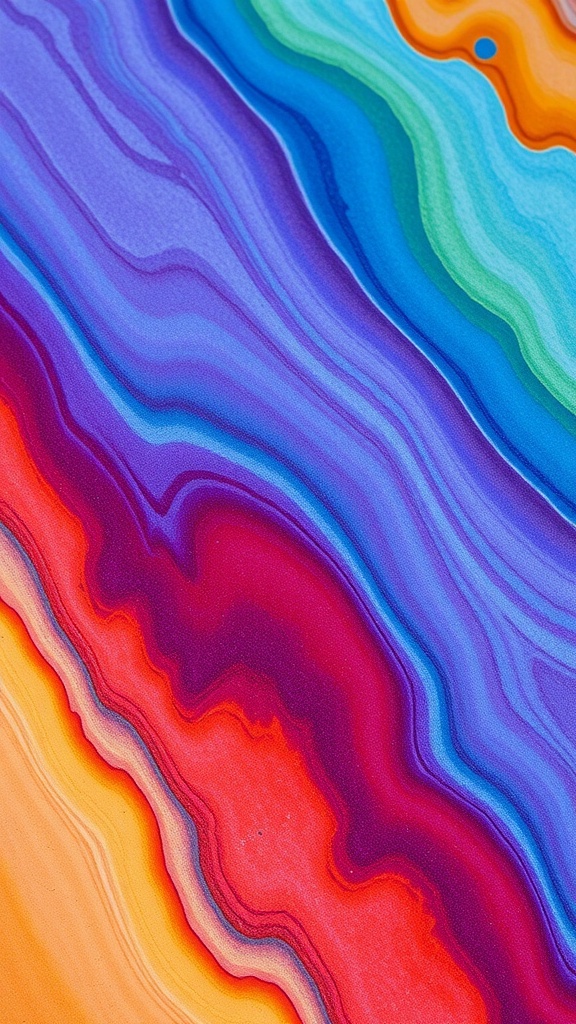
Concrete floors can be both functional and stylish, especially when you use natural pigments. The image above beautifully illustrates how vibrant colors can transform a simple concrete floor into a lively artwork. The deep reds, yellows, and oranges splash across the surface, creating an inviting atmosphere.
Using natural pigments in concrete is an eco-friendly choice. These pigments are made from earth materials, reducing the carbon footprint compared to synthetic dyes. Not only are they safer for the environment, but they also provide a unique, organic look that synthetic options can’t replicate.
The process of adding natural pigments is straightforward. First, mix the pigments with the concrete mix. Then, pour the mixture into your desired area. As the concrete sets, the pigments blend seamlessly, giving you a rich, colorful floor. This can be a fun DIY project for anyone looking to personalize their space.
Beyond aesthetics, these pigments can also enhance durability. The colors become embedded within the concrete, making them resistant to fading over time. This longevity ensures that your colorful floor remains vibrant for years to come.
The Process of Installing Eco-Friendly Concrete Floors
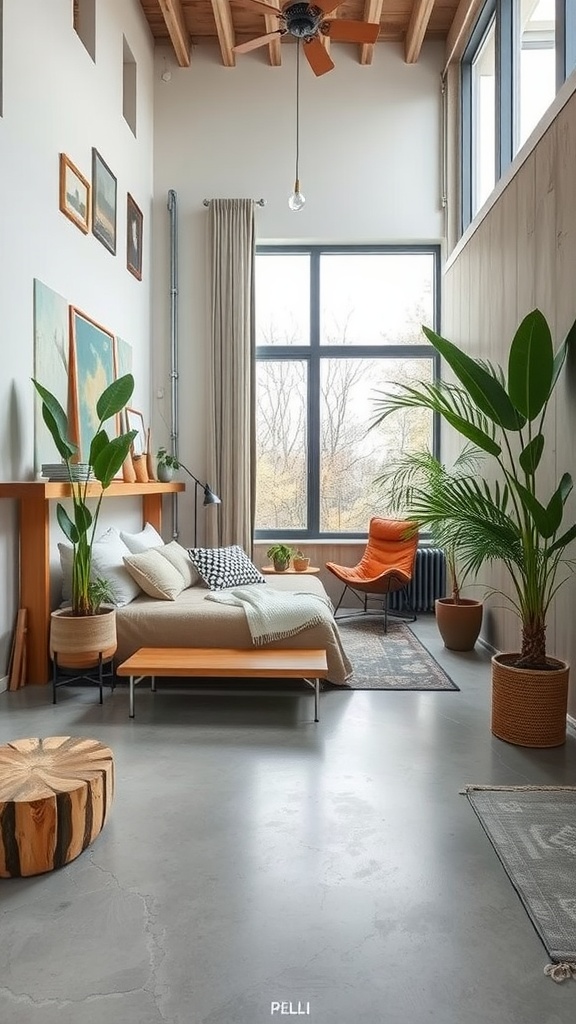
Installing eco-friendly concrete floors is a step towards a more sustainable home. The process may seem daunting, but it can be broken down into manageable steps. First, choose the right mix of concrete that incorporates recycled materials. This not only helps the environment but can also add unique aesthetics to your space.
Next, prepare the area where the flooring will be laid. This involves cleaning the surface and ensuring it’s level. A level surface is crucial for a smooth finish. Then, it’s time to pour the concrete. Working with a professional can make this step smoother, but DIY enthusiasts can certainly tackle it with some preparation.
Once the concrete is poured, it needs to be finished properly. This could involve polishing or sealing the surface to enhance durability and appearance. The finishing touches make a significant difference in how the floor looks and performs over time.
Finally, allow the concrete to cure. Curing is essential for strength and longevity. Be patient during this phase, as your eco-friendly flooring will reward you with a long-lasting, stylish look.
Maintenance Tips for Eco-Friendly Concrete Floors
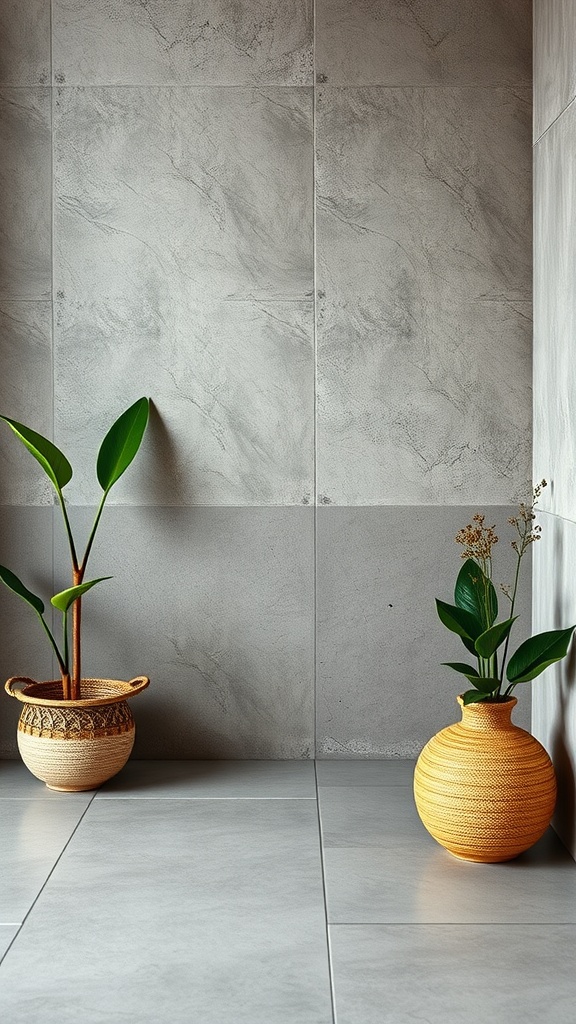
Concrete floors are a stylish and sustainable choice for modern homes. They can be both durable and eco-friendly, making them an appealing option for many homeowners. With the right care, your concrete floors can last for years while maintaining their look.
In the image, we see a clean and bright space with a mop and eco-friendly cleaning products. This setup reflects the maintenance routine that keeps eco-friendly concrete floors in excellent condition. Regular cleaning is key to preserving their beauty.
Start by sweeping or vacuuming regularly to remove dirt and debris. This prevents scratches and keeps your floors looking fresh. For deeper cleaning, use a damp mop with a gentle, non-toxic cleaner. The cleaner in the image suggests a focus on environmentally safe choices, which is essential for maintaining an eco-friendly home.
Spills should be cleaned up promptly to avoid staining. A simple mixture of water and vinegar can work wonders for tough spots. The products seen in the background highlight the importance of using cleaners that are safe for both your home and the environment.
Finally, consider applying a sealant every few years. This can help protect your floors from moisture and stains while enhancing their longevity. With these maintenance tips, your eco-friendly concrete floors will continue to shine and support a sustainable lifestyle.
The Impact of Concrete on Carbon Footprint
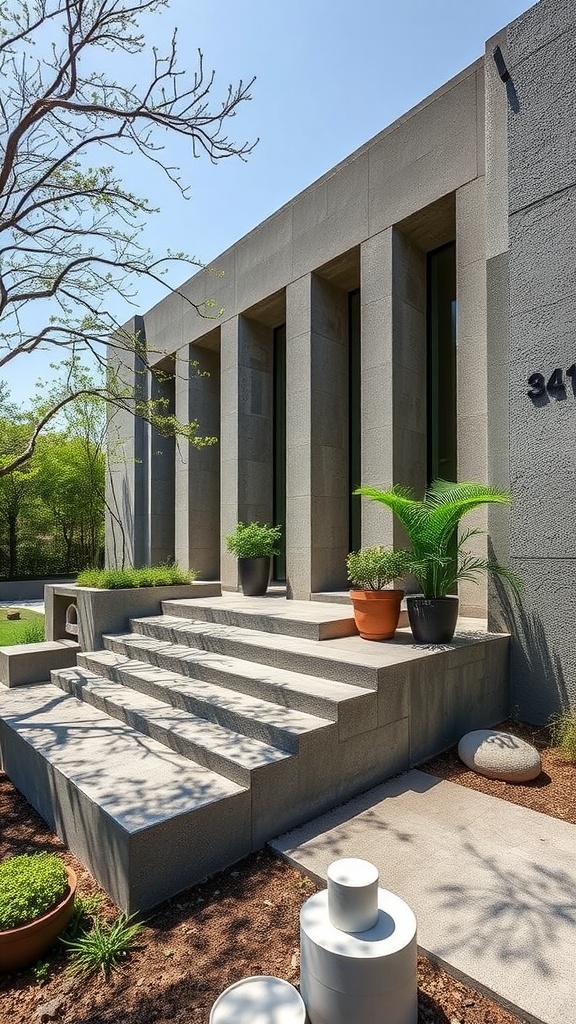
The image illustrates a vibrant street lined with trees, showcasing the contrast between traditional concrete and a newer eco-friendly alternative, SCAPRON. This visual representation is vital for understanding how concrete affects our carbon footprint.
Concrete has long been a staple in construction, but it comes with a hefty environmental cost. When we think about the materials we use, we often overlook the carbon emissions associated with traditional concrete production. The graphic in the image highlights the stark difference in carbon impact between traditional concrete and SCAPRON.
In the comparison, traditional concrete shows significantly higher carbon emissions, represented by the tall bars on the left. This means that while concrete is durable and practical, it is not the friendliest option for our planet. On the other hand, SCAPRON has a much lower carbon footprint, making it a more sustainable choice for eco-conscious builders.
The green trees in the background of the image symbolize growth and sustainability. This aligns perfectly with the idea that we can build homes that are not only beautiful but also reduce our impact on the environment. By opting for eco-friendly concrete floors, homeowners can contribute to a healthier planet while still enjoying the benefits of a sturdy and stylish surface.
Comparing Eco-Friendly Concrete to Other Flooring Types
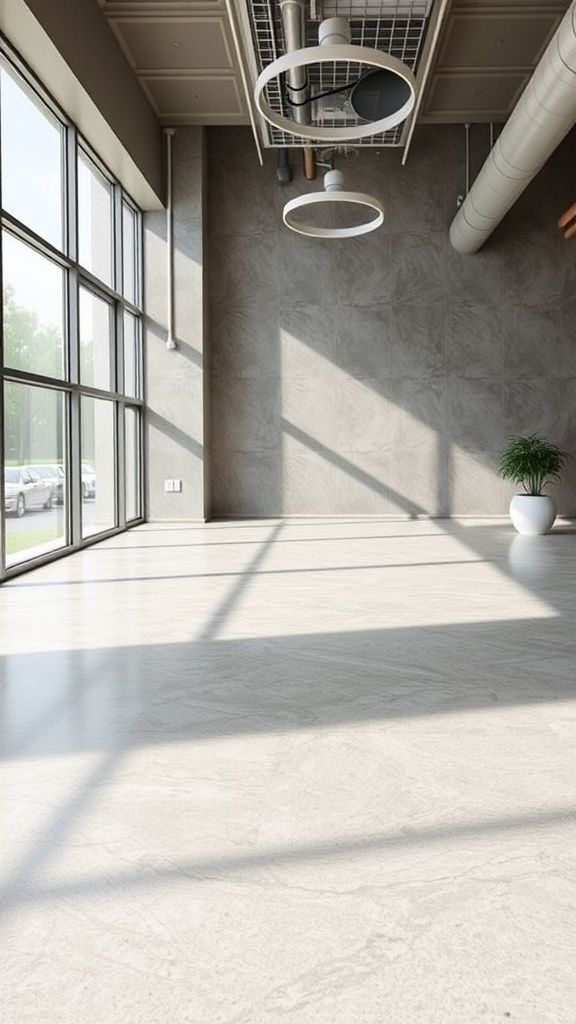
In the world of sustainable homes, eco-friendly concrete floors stand out for several reasons. The image showcases a sleek, modern space featuring concrete flooring, which perfectly illustrates the blend of style and sustainability. With its clean lines and natural tones, eco-friendly concrete not only looks good but also aligns well with green building practices.
When compared to traditional flooring types like hardwood or vinyl, eco-friendly concrete offers a unique set of advantages. For starters, it’s made from materials that can often be recycled or sourced sustainably. This contrasts sharply with many other flooring options that rely on finite resources or harmful chemicals.
Another benefit of eco-friendly concrete is its durability. Floors made from this material can withstand wear and tear much better than softer options. This means they’ll last longer and require fewer replacements, which is a win for both your wallet and the planet. Plus, they’re easier to maintain, needing little more than regular cleaning to keep them looking fresh.
On the other hand, traditional carpeting can trap dust and allergens, making it less suitable for those with sensitivities. Eco-friendly concrete's smooth surface doesn’t harbor the same issues, contributing to better air quality indoors.
In summary, while other flooring types may have their charm, the benefits of eco-friendly concrete make it a compelling choice for those looking to create a sustainable home without sacrificing style or comfort.
The Future of Eco-Friendly Concrete Innovations
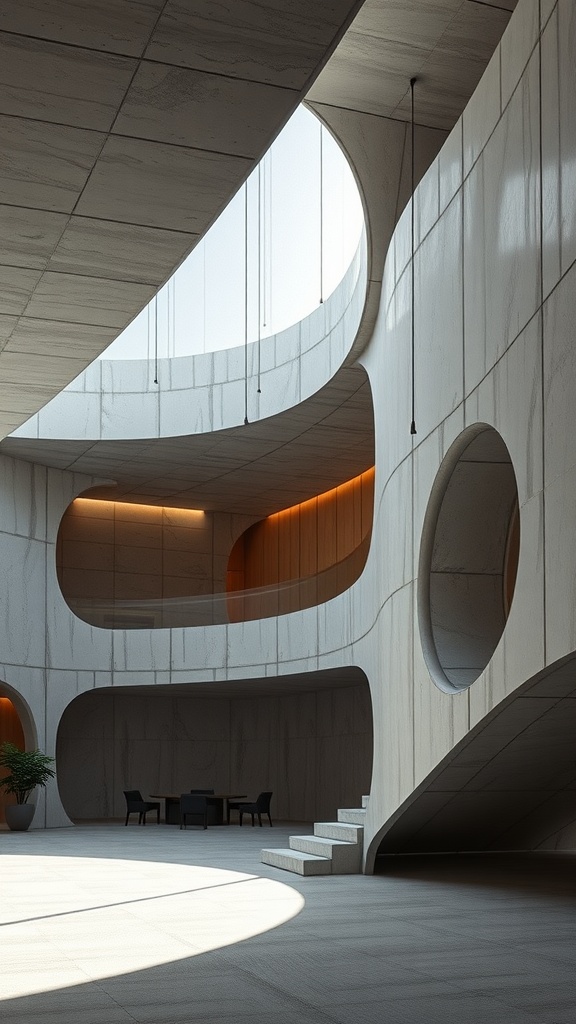
The image showcases a stunning modern space with smooth, flowing concrete surfaces. The design highlights how eco-friendly concrete can enhance a home’s aesthetics while being sustainable.
In recent years, the concrete industry has focused on reducing its environmental impact. New types of eco-friendly concrete materials are being developed, using recycled materials and alternative binders. This means that your floors can be both stylish and sustainable.
Additionally, the open, airy design in the image reflects the trend of integrating natural light and outdoor elements into modern homes. Such designs not only look appealing but also reduce the need for artificial lighting, further promoting energy efficiency.
As we move towards sustainable living, these innovations in concrete flooring are becoming more prevalent. Homeowners can expect to see options that not only save energy but also contribute to a healthier indoor environment.
The Importance of Certifications in Eco-Friendly Concrete
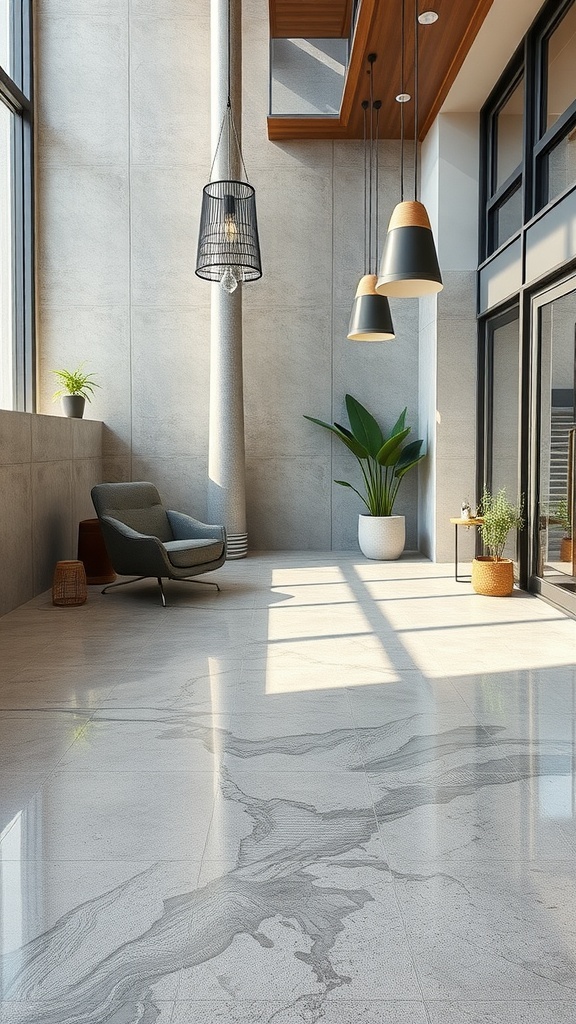
When choosing eco-friendly concrete for your home, certifications play a key role in ensuring you make a responsible choice. The image showcases various certifications displayed alongside stylish concrete samples. Each certification indicates that the product meets specific environmental and quality standards.
These certifications help homeowners identify products that are truly eco-friendly. They assure you that the materials used are sustainable and that the manufacturing processes are environmentally conscious. This is vital for anyone looking to create a green living space.
Among the certifications shown, you might see familiar logos from reputable organizations. Each one signifies compliance with strict guidelines in material sourcing, energy use, and waste management. When you see these logos, you can feel confident that your concrete floors are not just beautiful but also contribute positively to the environment.
Concrete's Role in Passive Solar Design

Concrete plays a crucial role in creating a comfortable and energy-efficient home. In this image, we see a well-designed space that utilizes concrete flooring as part of its passive solar system.
The large windows let in plenty of natural light, while the concrete absorbs heat during the day. This design helps maintain warmth even when the sun sets. The sun’s rays hit the floor, warming the concrete, which then radiates that heat back into the room, keeping it cozy without extra energy use.
This method is called thermal mass. The concrete's density allows it to store energy, making it invaluable for homes focused on sustainability. It not only helps regulate temperature but also reduces reliance on heating systems.
Incorporating passive solar design with concrete floors can lead to significant savings on energy bills. It's a smart choice for anyone looking to make their home more eco-friendly and comfortable.
Local Sourcing of Materials for Concrete Floors

Choosing local materials for concrete floors can significantly reduce your carbon footprint. When you source materials nearby, you minimize transportation emissions and support local businesses. This practice not only benefits the environment but also fosters a sense of community.
Local sourcing allows you to tap into regional resources, which can lead to unique design opportunities. For instance, some areas have distinctive aggregates that can enhance the aesthetic appeal of your concrete floors. These local elements can tell a story about the place where you live, making your home feel more connected to its surroundings.
Additionally, working with local suppliers often means fresher materials. This can translate into better durability and performance. Plus, fostering relationships with local vendors can result in tailored solutions that meet your specific needs.
Incorporating local materials into your home is a simple way to embrace sustainability. By making this choice, you not only contribute to a healthier planet but also create a space that reflects your local culture and heritage.
Case Studies of Sustainable Homes
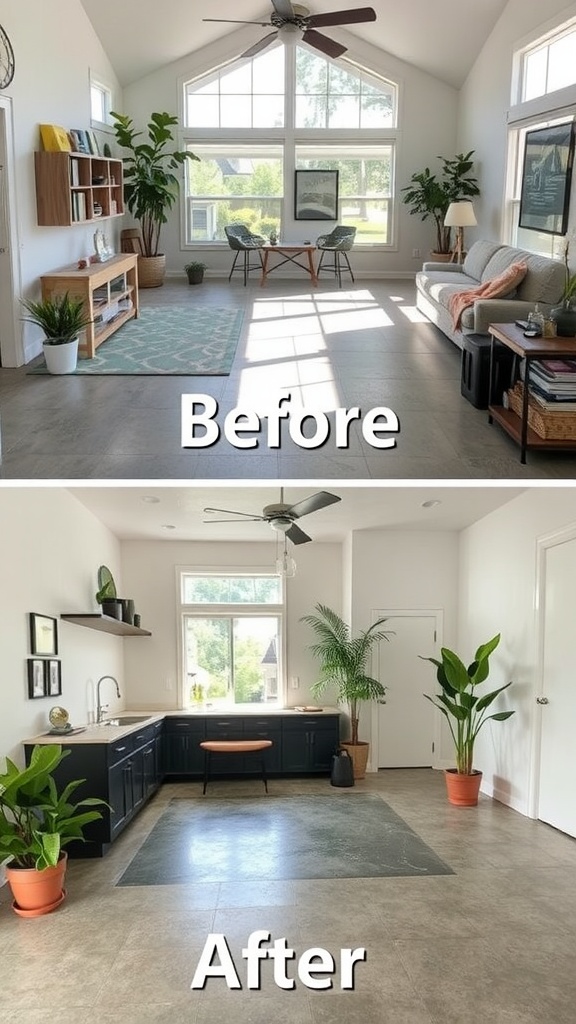
In this section, we explore how eco-friendly concrete floors can enhance sustainable homes. The image above showcases a dramatic transformation of a living space, highlighting the versatility of concrete flooring.
The 'before' scene has a cozy, but somewhat dated look, featuring traditional flooring that may not align with modern sustainability goals. In contrast, the 'after' image reveals a sleek concrete floor that brings a fresh vibe. This update reflects a commitment to both aesthetics and eco-conscious choices.
Sustainable materials like concrete not only offer durability but also help maintain indoor air quality. By using eco-friendly finishes, homeowners can create a space that's both stylish and sustainable.
This transformation demonstrates how making simple changes in flooring can lead to a more environmentally friendly home. By embracing materials like concrete, we can support a greener future while enjoying beautiful living spaces.
Community Initiatives for Promoting Eco-Friendly Concrete
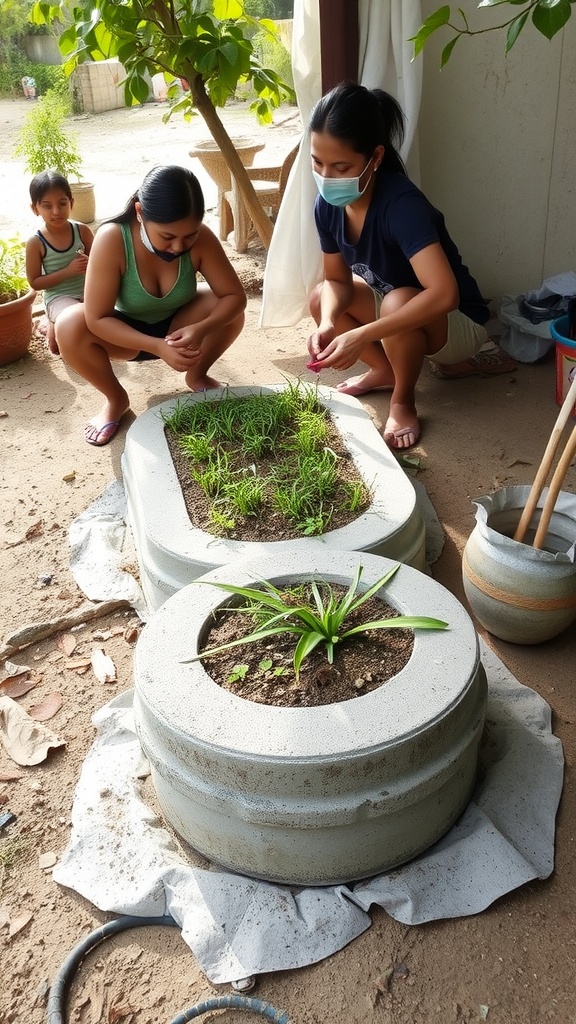
In the quest for sustainable living, community initiatives play a vital role in promoting eco-friendly concrete. The image captures a group of individuals engaged in a collaborative effort within a serene outdoor setting. This kind of environment fosters creativity and teamwork, essential for spreading awareness about eco-friendly building materials.
The large lettering on the wall, 'salution', symbolizes a warm welcome to new ideas and practices. Community gatherings like this create a space where people can share knowledge about sustainable choices, including eco-friendly concrete options. These concrete alternatives not only reduce environmental impact but also enhance the aesthetics of modern homes.
As people gather around tables, they are likely discussing ways to implement eco-friendly concrete in local projects. Informative workshops, hands-on demonstrations, and interactive sessions can spark interest and motivate individuals to advocate for greener building methods in their neighborhoods. Such initiatives help build a supportive network, making it easier for homeowners and builders to embrace sustainable practices.
Ultimately, the synergy created in these community settings can lead to more sustainable homes that benefit both the environment and the community. Emphasizing collaboration and education, these gatherings are crucial for paving the way toward a greener future.
Exploring Global Trends in Sustainable Concrete Use

The image showcases a world map superimposed on a beautifully textured concrete floor, highlighting the global interest in eco-friendly materials. This visual representation reminds us that sustainability is a worldwide concern, with many regions embracing green building practices.
Concrete, often seen as a heavy material, is undergoing a transformation. Countries across the globe are exploring ways to make concrete more sustainable. For instance, using recycled materials or incorporating alternative binding agents reduces the environmental impact of traditional concrete.
As we look at various regions, it's clear that sustainable concrete practices are not limited to one area. From North America to Asia, communities are adopting methods that align with eco-friendly initiatives. This trend reflects a collective desire to minimize carbon footprints while creating functional and stylish spaces.
Additionally, the growing popularity of concrete floors in homes is a clear indicator of changing preferences. Homeowners are increasingly drawn to the durability and low maintenance of these surfaces. By choosing eco-friendly options, they're not just investing in aesthetics but also in the future of our planet.
Personalizing Your Eco-Friendly Concrete Floors
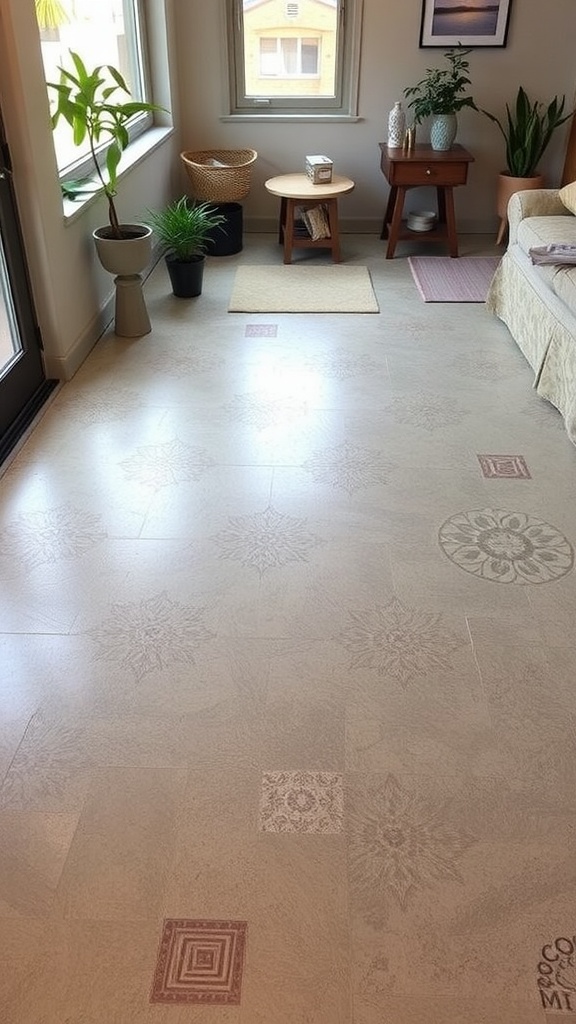
Concrete floors can be more than just a practical choice for your home; they’re also a canvas for creativity. The image perfectly illustrates how you can personalize these surfaces to reflect your style while maintaining a focus on sustainability. The natural light pouring in through the large windows highlights the beauty of the concrete, making it feel warm and inviting.
The subtle textures and shades of gray in the concrete can be enhanced with various finishes. Consider polishing the surface for a sleek look, or adding a stamped design for a unique touch. This allows you to blend functionality with artistic expression seamlessly.
Incorporating plants, like the ones in the image, adds an organic element that softens the industrial feel of concrete. This not only improves air quality but also creates a calming atmosphere in your space. Choosing eco-friendly plant pots can further enhance the sustainability factor.
Text and graphics, like the bold letters shown, can also be integrated into your concrete floors. This is a fun way to add a personal touch, whether it’s a favorite quote, your family name, or a unique design. The options are endless and can truly set your space apart.
Overall, personalizing your eco-friendly concrete floors allows for a blend of style and sustainability, ensuring your home reflects your taste while being mindful of the environment.
- Get link
- X
- Other Apps

Comments
Post a Comment